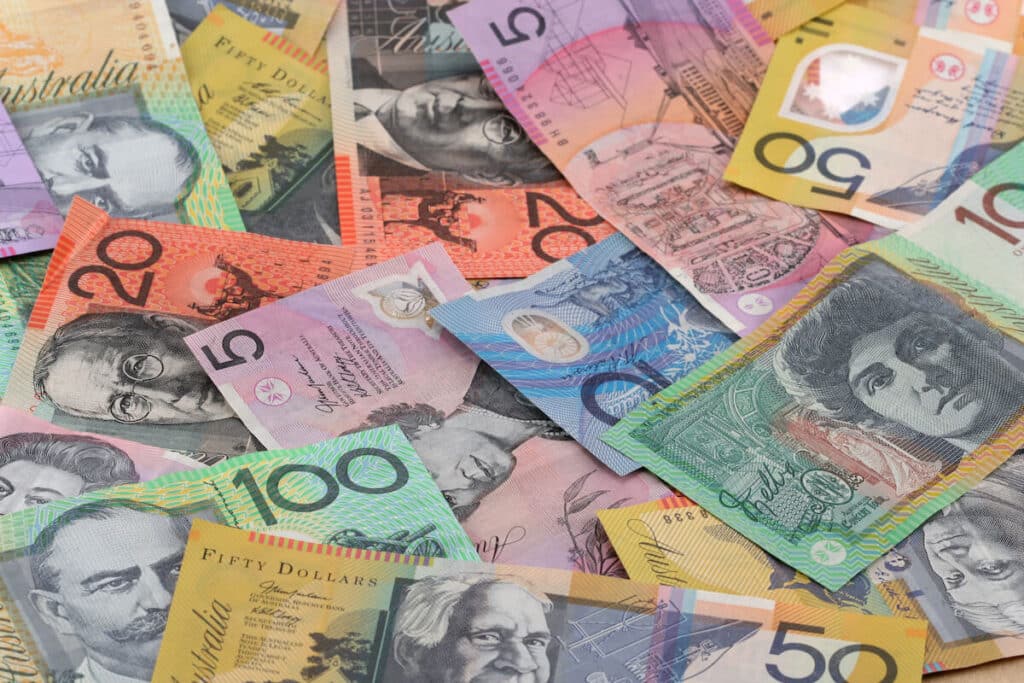Last updated on March 21st, 2023 at 04:59 pm
Australia is one of several countries in the world that uses the dollar as its official unit of currency. But Australian currency differs from other dollars in several ways, including its design, its history, and its exchange rate.
Whether you’re moving to Australia or just visiting, it’s worth getting to know the official currency of Australia and how to navigate Australia’s financial system. Here’s our guide to Australian currency—including how to send money to Australia, how to pay for goods and services, and more.
The history of Australian currency
People have lived on the Australian continent for tens of thousands of years. According to the Royal Australian Mint, indigenous currency revolved around a barter system, with tools, shells, and other items traded for food and supplies.
Europeans established the first colony in Australia in 1788, and they brought their own currencies with them, including the Spanish dollar and the British pound. But with wars going on in Europe, there wasn’t enough money to go around, and rum “became a de-facto currency,” according to historian Matt Murphy.
Eventually, individual states introduced their own forms of legal tender, including gold sovereigns, treasury notes, and other coins and banknotes.
When Australia became a federation in 1901, the federal government took over the responsibility of issuing money and formed the Commonwealth Treasury. The first Australian currency consisted of pounds, shillings, and pence—just like the British pound sterling that inspired it.
In 1966, the Australian dollar replaced the pound, with 1 Australian dollar divided into 100 cents—just like the U.S. dollar (USD) and New Zealand dollar (NZD).
Australian currency denominations

The Reserve Bank of Australia (RBA) issues Australian currency, with coins produced by the Royal Australian Mint in Canberra, and banknotes by Note Printing Australia.
Australian coins come in six denominations: 5, 10, 20, and 50 cents, as well as $1 and $2 coinage. Smaller units, including 1-cent and 2-cent coins, are rare.
As for paper currency, you’ll find $5, $10, $20, $50, and $100 banknotes, with the most recent editions issued between 2016 and 2020.
6 memorable facts about the Australian dollar
With its colorful banknotes and distinct coinage, Australian currency clearly stands out from other dollar currencies. Although it uses the same symbol as the U.S. dollar, you can identify it by the letters AUD on your favorite currency converter.
Here are six other facts that set the Australian dollar apart.
1. Australia’s currency features British royalty.
Australia is part of the British Commonwealth, which means that the British monarch is technically its “head of state.” Australia acknowledges this on its currency, with the late Queen Elizabeth II depicted on some coins and banknotes. New coins featuring King Charles III are on their way and will arrive sometime in 2023.
2. Australian currency could have been called the “koala.”
Australia’s central bank “decimalized” its currency in 1966, replacing Australian pounds and shillings with a much simpler decimal currency.
But the name “dollar” wasn’t a shoe-in. The Prime Minister wanted to call it the “royal,” while members of the public suggested the “dinkum,” “roo,” “kanga,” and “koala.”
Eventually, “dollar” won out, and the Australian dollar—or the “Aussie dollar”, as the locals call it—has been legal tender ever since.
3. The AUD is the official currency of several other countries.
Head to Singapore or New Zealand—two other countries that use the dollar—and you’ll have to trade in your Aussie dollars for the local currency.
But there are a few countries that accept the Australian dollar as legal tender. Nauru uses the Australian dollar as its official currency, while Tuvalu and Kiribati have their own coins that are pegged to the AUD and used along with it.
The Australian dollar is also used in several overseas territories, including Christmas Island, the Cocos (Keeling) Island, and Norfolk Island.
And for several years in the 1960s and 1970s, it was the official currency of Papua New Guinea and the Solomon Islands.
4. Australia introduced the world’s first polymer banknotes.
Australia leads the way when it comes to the security and durability of its money. It was the first country to issue polymer banknotes in 1988, which are cleaner and last longer than traditional paper banknotes.
They also have advanced security features, including fluorescent ink, microprint, and other attributes to prevent fraud and counterfeiting.
5. The Australian dollar is the sixth-most-traded currency.
The Australian dollar was the sixth-most-traded currency in 2022, behind the euro (EUR), the United States dollar (USD), the Japanese yen (JPY), the British pound (GBP), and the Chinese yuan (CNY). It accounted for 6% of foreign exchange transactions.
6. Australia has a high-tech banking sector.
Australia has one of the most advanced banking systems in the world, with its biggest banks connected by an instant payment system called Osko.
Its financial center is based in Sydney, followed closely by Melbourne, with Sydney ranking top 13 and Melbourne ranking top 31 financial centers in the world in 2022.
The country is also home to over 775 fintech companies developing new tools in the fields of lending, insurance, and personal finance.
How to pay for goods and services in Australia

If you’re thinking of applying for a temporary Australian work visa or moving to Australia as a permanent resident, you’re going to want to get familiar with Australian currency.
Fortunately, it’s easy to get a bank account and send money to and from Australia. You don’t need to bring traveler’s checks with you. In fact, you may find them hard to cash, and more expensive than other options.
Most Australian businesses accept debit cards and credit cards, and there are ATMs available in all major cities and even small towns.
Of course, if you’re using a credit or debit card from another country, your bank may charge fees for international transactions, so you may want to withdraw cash from an ATM or open a local bank account rather than pay a fee on every purchase.
You can open a free account with any of the big Australian banks—such as National Australia Bank—or choose an online-only “neobank” with built-in budgeting tools.
When it comes to hard currency, you don’t need to carry around a lot of cash. Australia doesn’t have a significant tipping culture, and even small vendors will accept payments with a credit card or digital wallet.
Australian currency exchange rates
Whether you’re a visitor or a resident, it’s a good idea to keep an eye on the Australian dollar exchange rate. Because Australia has a high cost of living, expect things to cost more than they do in your home country.
The Australian dollar is a stable currency, but its value can fluctuate over time based on monetary policy, commodity prices, exports, interest rates, and other factors.
As a general rule, the Australian dollar is slightly stronger than the New Zealand dollar and weaker than the U.S. dollar.
You can use a currency converter to check the current conversion rate between 1 AUD and your home currency. Then, use an international money transfer app like Remitly to send money home when the AUD is strong so you can get the best rates.
Send money back home the easy way

Australia is a country of immigrants, with 30% of residents born outside the country. So it’s no surprise that many of those residents need to send money to family and friends back home. Having a convenient way to transfer Australian currency is a must.
Remitly makes it easy to send money from Australia with our money transfer app. You can fund your transfer with a debit or credit card—or with a bank account—and send it directly to your loved one’s bank account or a cash pickup location.
You can view the Australian dollar exchange rate before each transaction to ensure that you’re getting the best rate. Plus, you’ll get notifications every step of the way.
Download the app today to set up your first transfer!
